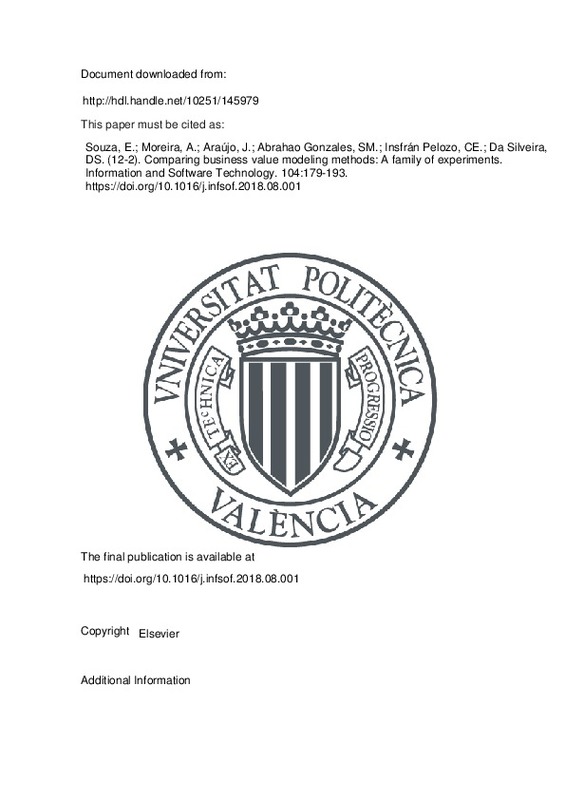JavaScript is disabled for your browser. Some features of this site may not work without it.
Buscar en RiuNet
Listar
Mi cuenta
Estadísticas
Ayuda RiuNet
Admin. UPV
Comparing business value modeling methods: A family of experiments
Mostrar el registro sencillo del ítem
Ficheros en el ítem
| dc.contributor.author | Souza, Eric
|
es_ES |
| dc.contributor.author | Moreira, Ana
|
es_ES |
| dc.contributor.author | Araújo, João
|
es_ES |
| dc.contributor.author | Abrahao Gonzales, Silvia Mara
|
es_ES |
| dc.contributor.author | Insfrán Pelozo, César Emilio
|
es_ES |
| dc.contributor.author | Da Silveira, Denis Silva
|
es_ES |
| dc.date.accessioned | 2020-06-11T03:32:39Z | |
| dc.date.available | 2020-06-11T03:32:39Z | |
| dc.date.issued | 2018-12 | es_ES |
| dc.identifier.issn | 0950-5849 | es_ES |
| dc.identifier.uri | http://hdl.handle.net/10251/145979 | |
| dc.description.abstract | [EN] Context A value model is used to describe how an organization creates, delivers, and captures its business value. Value-driven development methods use the notion of "economic value exchange" to define more efficient business strategies and align Information Systems (IS) with organizational goals. Current value-driven methods are complex and there is insufficient empirical evidence regarding which of the existing methods are more effective. Objective: This paper compares two different value-driven methods to provide empirical evidence regarding both their efficacy when modeling business value and their likelihood of acceptance in practice. Method: This goal was addressed by performing a family of three controlled experiments with a group of novice software engineers and business analysts to compare the Dynamic Value Description (DVD) method with the e3value method, with respect to their effectiveness, efficiency, perceived ease of use, perceived usefulness and intention to use. The experiment was initially performed in Spain and then replicated in Portugal and Brazil with other participants with different backgrounds. A meta-analysis was performed to aggregate the empirical findings obtained in each experiment. Results: The results indicate that the DVD method is superior with respect to all the variables analyzed. Conclusion: The DVD method is a promising and alternative method to specify business value when compared to the well-known e3value method for the analyzed variables. | es_ES |
| dc.description.sponsorship | We should first like to thank the participants from Spain, Portugal and Brazil who took part in these experiments, for their effort and valuable time. We would also like to thank the Value@Cloud project (MINECO TIN2013-46300-R), the NOVA LINCS Research Laboratory (Ref. UID/CEC/04516/2013), and CAPES - Ciencia sem Fronteiras (Ref. 99999.009047/2013-01) for their financial support. | es_ES |
| dc.language | Inglés | es_ES |
| dc.publisher | Elsevier | es_ES |
| dc.relation.ispartof | Information and Software Technology | es_ES |
| dc.rights | Reconocimiento - No comercial - Sin obra derivada (by-nc-nd) | es_ES |
| dc.subject | Value model | es_ES |
| dc.subject | Value-driven | es_ES |
| dc.subject | Controlled experiment | es_ES |
| dc.subject.classification | LENGUAJES Y SISTEMAS INFORMATICOS | es_ES |
| dc.title | Comparing business value modeling methods: A family of experiments | es_ES |
| dc.type | Artículo | es_ES |
| dc.identifier.doi | 10.1016/j.infsof.2018.08.001 | es_ES |
| dc.relation.projectID | info:eu-repo/grantAgreement/FCT/5876/147279/PT/NOVA Laboratory for Computer Science and Informatics/ | |
| dc.relation.projectID | info:eu-repo/grantAgreement/MINECO//TIN2013-46300-R/ES/DESARROLLO INCREMENTAL DE SERVICIOS CLOUD DIRIGIDO POR MODELOS Y ORIENTADO AL VALOR DEL CLIENTE/ | es_ES |
| dc.relation.projectID | info:eu-repo/grantAgreement/CAPES//99999.009047%2F2013-01/ | es_ES |
| dc.relation.projectID | info:eu-repo/grantAgreement/AEI/Plan Estatal de Investigación Científica y Técnica y de Innovación 2013-2016/TIN2017-84550-R/ES/ADAPTACION DINAMICA DE SERVICIOS CLOUD CENTRADA EN EL USUARIO/ | es_ES |
| dc.rights.accessRights | Abierto | es_ES |
| dc.contributor.affiliation | Universitat Politècnica de València. Departamento de Sistemas Informáticos y Computación - Departament de Sistemes Informàtics i Computació | es_ES |
| dc.description.bibliographicCitation | Souza, E.; Moreira, A.; Araújo, J.; Abrahao Gonzales, SM.; Insfrán Pelozo, CE.; Da Silveira, DS. (2018). Comparing business value modeling methods: A family of experiments. Information and Software Technology. 104:179-193. https://doi.org/10.1016/j.infsof.2018.08.001 | es_ES |
| dc.description.accrualMethod | S | es_ES |
| dc.relation.publisherversion | https://doi.org/10.1016/j.infsof.2018.08.001 | es_ES |
| dc.description.upvformatpinicio | 179 | es_ES |
| dc.description.upvformatpfin | 193 | es_ES |
| dc.type.version | info:eu-repo/semantics/publishedVersion | es_ES |
| dc.description.volume | 104 | es_ES |
| dc.relation.pasarela | S\376184 | es_ES |
| dc.contributor.funder | Agencia Estatal de Investigación | es_ES |
| dc.contributor.funder | Ministerio de Economía y Empresa | es_ES |
| dc.contributor.funder | Ministerio de Economía, Industria y Competitividad | es_ES |
| dc.contributor.funder | Fundação para a Ciência e a Tecnologia, Portugal | es_ES |
| dc.contributor.funder | Coordenaçao de Aperfeiçoamento de Pessoal de Nível Superior, Brasil | es_ES |







![[Cerrado]](/themes/UPV/images/candado.png)

